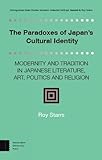The Paradoxes of Japan's Cultural Identity : Modernity and Tradition in Japanese Literature, Art, Politics and Religion / Roy Starrs.
Material type: TextSeries: Distinguished Asia Studies Scholars: Collected Writings ; 6Publisher: Amsterdam : Amsterdam University Press, [2023]Copyright date: ©2023Description: 1 online resource (324 p.)Content type:
TextSeries: Distinguished Asia Studies Scholars: Collected Writings ; 6Publisher: Amsterdam : Amsterdam University Press, [2023]Copyright date: ©2023Description: 1 online resource (324 p.)Content type: - 9789048559763
- Japanese literature -- History and criticism
- Asian Studies
- Contemporary History
- Contemporary Society
- Cultural Studies
- East Asia and North East Asia
- Interdisciplinary Studies
- Literary Theory, Criticism, and History
- Sociology and Social History
- HISTORY / Asia / Japan
- Japan, culture. literature, politics, religion
- 305.800952 23//eng/20231016eng
- online - DeGruyter
| Item type | Current library | Call number | URL | Status | Notes | Barcode | |
|---|---|---|---|---|---|---|---|
 eBook
eBook
|
Biblioteca "Angelicum" Pont. Univ. S.Tommaso d'Aquino Nuvola online | online - DeGruyter (Browse shelf(Opens below)) | Online access | Not for loan (Accesso limitato) | Accesso per gli utenti autorizzati / Access for authorized users | (dgr)9789048559763 |
Frontmatter -- Contents -- Acknowledgements -- Foreword -- Introduction -- Part One: Japanese Politics, Religion and Society -- 1. Politics and Religion in Japan -- 2. The Kojiki as Japan’s National Narrative -- 3. Prince Shōtoku and Japan’s ‘China Complex’ -- 4. Japan’s Perennial New Man: The Liberal and Fascist Incarnations of Masamichi Rōyama -- 5. From Mishima to Aum: Religiopolitical Violence in Late Twentieth-Century Japan -- Part Two: Japanese Literature and Art -- 6. Japanese Poetry and the Aesthetics of Disaster -- 7. In Search of the Great Meiji Novel: From Ukigumo to Yoake mae -- 8. Nation and Region in the Work of Dazai Osamu -- 9. Ink Traces of the Dancing Calligraphers: Zen-ei Sho in Japan Today -- 10. Mishima, Bowie and the Anti-Metaphysics of the Mask -- 11. D.T. Suzuki’s Theory of Inspiration and the Challenges of Cross-Cultural Transmission -- Part Three: Selected Reviews -- 12. Ninomiya Masayuki, La pensée de Kobayashi Hideo: Un intellectuel japonais au tournant de l’histoire -- 13. Doug Slaymaker, Confluences: Postwar France and Japan -- 14. Alex Bates, The Culture of the Quake: The Great Kantō Earthquake and Taishō Japan -- 15. Alan Tansman, The Aesthetics of Japanese Fascism -- 16. Japanese Literature as a Modern Invention: a review of Haruo Shirane and Tomi Suzuki (eds.), Inventing the Classics: Modernity, National Identity, and Japanese Literature -- 17. Haruo Shirane, Japan and the Culture of the Four Seasons: Nature, Literature, and the Arts -- 18. Steven Heine and Dale S. Wright (eds.), Zen Masters -- Bibliography of Roy Starrs Publications -- Notes -- Index
restricted access online access with authorization star
http://purl.org/coar/access_right/c_16ec
Japan is widely regarded as having a unique culture and a strong national identity. Paradoxically, however, many basic elements of Japanese culture are not originally Japanese. Since the beginning of its history, Japan has been one of the world’s major importers of foreign cultures. Its culture was thoroughly "hybrid" long before that word became fashionable in contemporary global studies. But this does not mean that Japan’s culture lacks originality. The Japanese have always made strikingly original contributions, even improvements, to whatever they imported. Even more significantly, the "hybridity" of their culture produced ongoing tensions that served as a kind of creative dynamo for Japanese writers, artists, and intellectuals. This book explores the fundamental creative tension between the native and the foreign in many areas of Japanese culture, from politics and religion to art and literature – a tension also often interpreted as between tradition and modernity.
Mode of access: Internet via World Wide Web.
In English.
Description based on online resource; title from PDF title page (publisher's Web site, viewed 02. Jun 2024)


